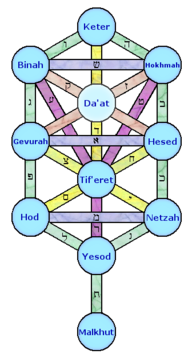- Malkuth
-
The Sefirot in Jewish Kabbalah 
Category:Sephirot Malkuth ("kingdom"; ملكوت;מלכות), or Shekhinah is the tenth of the sephirot in the Kabbalistic Tree of Life. It sits at the bottom of the Tree, below Yesod. This sephirah has as a symbol the Bride which relates to the sphere of Tipheret, symbolized by the Bridegroom.
Unlike the other nine sephirot, it is an attribute of God which does not emanate from God directly. Rather it emanates from God's creation—when that creation reflects and evinces God's glory from within itself.[1]
Contents
Hermetic & Christian Kabbalah
Malkuth means Kingdom. It is associated with the realm of matter/earth and relates to the physical world, the planets and the solar system. It is important not to think of this sephirah as merely "unspiritual," for even though it is the emanation furthest from the divine source, it is still on the Tree of Life. As the receiving sphere of all the other sephirot above it, Malkuth gives tangible form to the other emanations. It is like the negative node of an electrical circuit. The divine energy comes down and finds its expression in this plane, and our purpose as human beings is to bring that energy back around the circuit again and up the Tree.
Some occultists have also likened Malkuth to a cosmic filter, which lies above the world of the Qliphoth, or the Tree of Death, the world of chaos which is constructed from the imbalance of the original sephirot in the Tree of Life. For this reason it is associated with the feet and anus of the human body, the feet connecting the body to Earth, and the anus being the body's "filter" through which waste is excreted, just as Malkuth excretes unbalanced energy into the Qliphoth.
The archangel of this sphere is Sandalphon, and the Ishim (souls of fire) is the Angelic order. The name of God is Adonai Melekh or Adon ha-Arets. There is also a connection to the tenth card of each suit in Tarot.
Symbols associated with this sphere are a Bride (a young woman on a throne with a veil over her face) and a double cubed altar. Where Binah is known as the Superior Mother, this sphere is referred to as the Inferior Mother. It is also referred to as the bride of Macroprosopos, where Macroprosops is Kether.[2]
From a Christian viewpoint this sphere is important since Jesus preached that we should "seek first the Kingdom of God".
In some systems, it is equated with Daat, knowledge, the invisible sephirah.
In comparing with Eastern systems, Malkuth is a very similar archetypal idea to that of the Muladhara chakra, in Shakta tantra, which is also associated with the Earth, the plane in which karma is expressed.
Although Malkuth is seen as the lowest Sefirah on the tree of life, it also contains within it the potential to reach the highest. This is exemplified in the Hermetic maxim 'As above so below'.
Popular Culture
In Namco's game Tales of the Abyss, Malkuth is one of two kingdoms that fought over the fragments of thing known as Score, which could be used to read the future.
In Atlus's game Baroque, the Order of Malkuth is a group of False Angels who believe rather than God saving us, We must save God.
The song "Station to Station" by David Bowie includes the line "Here are we, one magical movement from Kether to Malkuth".
Swiss metal band Samael has a song titled "From Malkuth to Kether" on their EP Exodus.
Malkuth appears as one of the many forms of Zina Pallas in PK Dick's The Divine Invasion.
In CCP Games' EVE Online, the title 'Malkuth' appears in the names of several types of missile launchers.
References
- ^ Shimon Leiberman, Malchut: The Kingdom Within
- ^ Dion Fortune, The Mystical Qabalah, Antiquarian Press, Northamptonshire, 1987, p162
External links
Categories:
Wikimedia Foundation. 2010.

